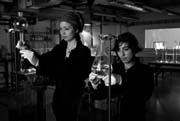Rachida Ziani and Dewi de Vree, two artist from the Hague, are developing Elektrolab, a series of electrical music performances and installations based on electrochemical principles. Elektrolab is based on the first battery, invented by Alessandro Volta in 1800. By making an 'open' battery in which the different elements are taken apart, enlarged and amplified, they show the process of generating electricity. A device of which many are hidden in the portable machines around us, is opened up and the beauty of this natural phenomenon is made visible. Most electronic machines and computer systems nowadays lack the tactile, sensory impressions that we experience in the rest of our daily surroundings. With Elektrolab, Ziani and de Vree are developing different sound interfaces in which various parameters of electronic sounds can be controlled by the manipulation of different chemical reactions. Elektrolab emphasizes the sensual perception and the physical control of invisible processes.This makes the set-up an interesting musical-theatrical work.
Rachida Ziani is a french artist, living and working in The Hague, The Netherlands. Rachida started her artistic formation in EPIAR, the International School of Contemporary Art, La Villa Arson, in Nice, where she researched and refined her skills in illustration and etching. Later on she developed a strong interest in music and sound, and a deep fascination for mechanical machines and devices, automatas and tricks used in abstract cinema and magical performances. Her growing interest in the interaction between the human and the machine led to the making of 'translating-machines' and sound interfaces. With these interfaces the beauty of electricity is shown by open up different electronic components. Together with Jeroen Uyttendaele she developed Graphite Circuits, sound installations and performances using graphite as a conductor for electricity. At the moment she is completing her studies ArtScience at the Royal Academy of Art in The Hague and together with Rachida Ziani she developes the Elektrolab series.
Dewi de Vree is a dutch artist. Her first works consist of drawings and paintings. At the VAV department at the Rietveld Academy in Amsterdam she developed her first interest in sound, natural phenomena and translations between time-based processes and still images. She created different graphic partitures, sound installations and performances. Together with Jeroen Uyttendaele she developed the sound installation Graphite Circuits.
At the moment she lives and works in The Hague and studies at ArtScience at the Royal Academy of Art, besides the collaboration with Rachida Ziani.
Elektrolab è il nome di una serie di performances e installazioni sonore basate su principi elettro-chimici, sviluppate da Rachida Ziani e Dewi de Vree. Il processo nasce ispirandosi al funzionamento della prima batteria inventata da Alessandro Volta nel 1800. Una batteria 'aperta' le cui singole componenti sono in questo caso scorporate, ingrandite e amplificate, per rendere visibile il processo di generazione del fenomeno elettrico. Un dispositivo normalmente nascosto all'interno di apparecchi portatili di uso quotidiano, viene scoperchiato per rendere omaggio alla bellezza del suo funzionamento. Con Elektrolab Rachida Ziani e Dewi de Vree sviluppano un insieme di interfacce sonore i cui parametri elettronici generatori di suono vengono controllati tramite la manipolazione delle diverse reazioni chimiche. Elektrolab è l'enfasi teatrale di processi invisibili, tra controllo fisico e sensualità percettiva.
Rachida Ziani, artista francese in Olanda, ha studiato grafica e incisione alla International School of Contemporary Art La Villa Arson di Nizza. Matura in un secondo momento l'interesse per la musica e il suono, scoprendo parallelamente il fascino di automi, dispositivi meccanici e trucchi utilizzati nel cinema e nella magia. Inizia a lavorare quindi sui sistemi e i software di traduzione necessari all'interazione uomo-macchina, smontandone le componenti e indagandone i potenziali estetici. Approda al progetto Elektrolab dopo la collaborazione con Jeroen Uyttendaele con cui sviluppa Graphite Circuits installazione sonora che utilizza la grafite come conduttore elettrico.
Dewi de Vree, artista olandese, studia disegno e pittura, iscrivendosi in seguito al VAV, il dipartimento audiovisuale della Rietveld Academy di Amsterdam, dove comincia a lavorare sulla processazione dell'immagine tra fenomenologia naturale, video e immagine fotografica. Le sue partiture grafiche, le installazioni sonore e le performance si concentrano sulla interazione uomo-macchina. Incontra Rachida Ziani nel progetto Graphite Circuits e assieme fondano Elektrolab, proseguendo le loro ricerche all' ArtScience Royal Academy of Art di Hague.
